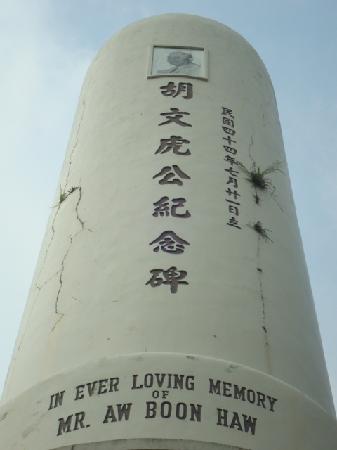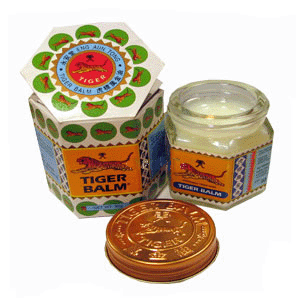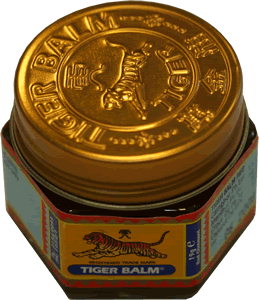Tiger Balm

|
Tiger Balm
pinyin: hǔbiao wànjīnyóu Tiger Ban Kim Ewe or "Ten Thousand Golden Oil" is the trade name for a heat rub or ointment manufactured and distributed by Haw Par Healthcare Limited in Singapore. It was originally developed in the 1870’s by an herbalist, Aw Chu Kin, in Rangoon, Burma, who asked his sons Aw Boon Haw and Aw Boon Par on his deathbed to perfect the product. Chinese people around the world will remember Tiger Balm, especially the older generations, as this was the medical herbal oil that accompanied them from childhood to old age. Even the young generations of today are familiar with Tiger Balm, as am I, as my parents, mum especially found out about the magic little jar during their time in Hong Kong, when dad was posted there. Tiger Balm is available in several varieties, the weaker Tiger Balm White (which is recommended for use with headaches) and the stronger Tiger Balm Red (which is not to be used on the head). There is also another version called Tiger Balm Ultra. I don’t like the red as it smells of cinnamon and I haven’t had the pleasure of finding the Tiger Balm Ultra, but I hope to. I grew up with and using the white and I buy a new jar every time I see it – last purchase – in a pharmacy in Tobago for the princely sum of one pound sixty, bargain, last one I bought in the Chinese shop on the Barbican in Plymouth, five pounds. Always on hand for bites, blocked nose, aches and pains. Personally devised use as a poultice for Bear when he hurts his knee or ankle. Slice of brown bread,
no crust. Slather one side with
Tiger Balm. Place on swollen joint. Cover with cling film to retain
heat. Bandage firmly and
leave overnight. Wash hands as not to
accidentally rub it in my eye. I know it sounds crazy and I was skeptical, but, it works
How did it all begin I wondered ??? Aw Chu
Kin (胡子钦) (? - 1908 in Rangoon, British Raj) was a Burmese
Chinese herbalist. He is best known as the original inventor of Tiger Balm. Aw
Chu Kin's father was a Chinese herbology practitioner in Xiamen and a Hakka from
Zhongchuan, Yongding, Fujian Province, China (福建省永定下洋中川村客家人). Being of a poor
background, Aw Chu Kin first immigrated to Singapore in 1863 where he stayed at
the kongsi of his clan at Telok Ayer Street. He then moved to Penang and started
to work as a practitioner of Traditional Chinese medicine, known as a
sinseh (先生) in Penang Hokkien.
Afterwards, he moved to Rangoon where, with the help of his uncle, founded his
medical hall or medical shop, named Eng Aun Tong (永安堂药行) ("The Hall of
Eternal Peace") in 1870, located at 644, Canton Road (仰光广东街644号). In respect of the
said balm, they adopted a trade mark consisting of the device of a tiger. The
word "TIGER" is taken from the name of the elder brother Aw Boon Haw. "Haw"
(虎) in Chinese means
the animal tiger. The Chinese word "Par," the name of the Younger brother means
the animal leopard. The trading name Eng Aun Tong was coined to denote the quality of the product from the popular medical hall in Rangoon. The trade mark TIGER and the device of a leaping tiger have been used in respect of the balm since 1900. When Aw Chu Kin died in 1908 at Rangoon,he left his medical hall, Eng Aun Tong, to his son, Aw Boon Par, having despaired of eldest son Boon Haw's rebel-rousing ways. The gentle leopard, finding the responsibility too much to bear, later asked for his older brother's return from China to carry on the family business in Rangoon.

Boon Par and Boon Haw
were charged with illicit trafficking in opium, and counterfeiting. The British
Chief Inspector of Police, Cyril Taylor, put the brothers under house arrest.
But the police were not able to pin anything on the brothers. Still, this was
humiliating to the brothers, Boon Haw decided to leave Burma and move the
business to Singapore. Although Aw Boon Par wished to stay in Rangoon, it was
because in addition to his two official wives (Piah Lan, Daw Saw who remained in
Rangoon), he had a secret wife, Hong Yin, in Rangoon. Mum always swore that the
Tiger Balm she very first bought in 1954 was “better” than modern stuff, she
asked a really elderly Chinese man why that was and he said he was sure the old
stuff had opium in it………. Nevertheless, Boon
Haw who had settled in Singapore in 1926 convinced him to immigrate, move the
family business and found the precursor of today's Haw Par Corporation. By 1926,
the headquarters of Eng Aun Tong "House of Eternal Peace" had been transferred
to Singapore. A new and larger factory was built at 89 Neil Road where
production was ten times greater than that of Rangoon's. The factory building, a
3-storey neo-classical building, is still standing prominently at the corner of
Neil Road and Craig Road - it was built by Aw Boon Haw in 1924. Boon Par took up
a residence at Tanglin Road in Singapore. The house eventually become known as
the "Jade House." Boon Par later moved to larger mansion at 178, Pasir Panjang
Road. The Aw brothers launched Sin Chew Jit Poh - their first paper - in
Singapore in 1929; mainly to advertise their tiger series of products. In 1932,
a Limited Company was incorporated in Singapore, know as Haw Par Brothers (Pvt.)
Ltd (“虎药有限公司”). It took over the
business of the two Aw brothers including their assets, such as trade marks.
From Singapore, the
company continued to carry on business and export Tiger Balm to various
countries, including India, until the Japanese occupation of Burma and Singapore
during World War II. The company devised various trade markets to be used in
various countries, the essential features of each of which was the device of a
leaping Tiger, the word "Tiger Balm" written in English and also in Chinese
characters. These trade marks were registered in different countries all over
the world. The occupation was to
become a major turning point in the history of several nations, including that
of Japan, Britain and the then colonial state of Singapore. Singapore was
renamed Syonan-to (昭南島 Shonan-to), which
means "Island of the Light of the South" or "Southern Island (obtained) during
Showa period". During the Japanese occupation of Singapore, Aw Boon Haw moved to
Hong Kong to manage the business from there, while Aw Boon Par stayed in
Singapore to run the factory.  Aw Boon Haw (胡文虎); born 1882 Rangoon, Burma - died 1954 Hong Kong, was a Burmese Chinese entrepreneur and philanthropist best known for introducing Tiger Balm. He was the son of Hakka herbalist Aw Chu Kin, with his ancestral home in Yongding County, Fujian Province. He was a very good negotiator and businessman. His life was not only business, how he managed to deal with KMT, CPC, Puppet government in China during Japanese occupation, and Japan government during WW2 was amazing... Aw migrated to Singapore in 1926, where he began the business of Tiger Red Balm with his brother, Aw Boon Par. Aw also founded several newspapers, including Sin Chew Jit Poh (星洲日報) on 15-1-1929 in Singapore, Sin Ping Jit Poh(星槟日报), now known as Guang Ming Daily (光明日報) was founded in 1939. Both of these newspapers are now based in Malaysia. A third Aw brothers newspaper, Sing Tao Daily (星島日報), dates back to 1-8-1938 and is currently based in Hong Kong. A fourth newspapaer, Sin Siam Jit Poh (星暹日报), was founded in 1951 in Bangkok, Thailand. Aw Boon Haw moved to
Hong Kong during the Japanese occupation of Singapore and managed the businesses
from there, while his brother stayed in Singapore until he closed down the
factory and went to Rangoon. Aw returned to Singapore after the end of World War
II and re-established his business.  1908: Taking over the business from the late father, together with brother Aw Boon Par. 1911: First branch outside Rangoon set up in Bangkok. 1926: He moved his head office to Singapore after the British conducted an unsuccessful opium raid in his house. He opened the Eng Aun Tong Medical Hall in Singapore. Turnover of his company reached $10 million. 1929: Founded Sin Chew Jit Poh, a Chinese newspaper competing with Tan Kah Kee's Nanyang Siang Pau. To further promote his Tiger products he also published the Tiger Standard. 1932: Moved his head office to Hong
Kong to capture the China market 1935: Built Haw Par Villa
in Hong Kong for his 2nd wife, Kyi Kyi. 1937: Built Haw Par Villa
otherwise known as the Tiger Balm Gardens for his brother, Boon Par. The gardens
depict Chinese mythology. 1938: An OBE conferred on
him for his philanthropic contributions. 1950: Set up the Chung
Khiaw Bank. He placed the management of the bank under the leadership of his
son-in-law, Lee Chee Shan, also a Burmese Chinese who arrived in Singapore in
1929. 1954: He died in Honolulu in September 1954 at the age of 72 years old, half-way home after a stomach operation in America. His empire was divided among six of his nine surviving children and four nephews. Sally Aw taking control of what is now the Sing Tao group (centered in Hong Kong with Sing Tao) and cousins forming Haw Par Brothers (centred in Singapore and including titles such as Sin Chew Jit Poh, which later experienced difficulty in competition with that nation's two dominant players). 

Sons: The 3rd wife (黄玉谢) has two sons It Haw (胡一虎), Er Haw (胡二虎) who passed away during WW2. The forth wife (邱秀英) give birth to two sons one daughter, Aw Sin (胡星), Aw San Haw (胡三虎) who passed away during World War II. Aw Si Haw (胡四虎). Aw It Haw (胡一虎) and Aw Si Haw (胡四虎) were still young when their father passed away. Aw It Haw (胡一虎) and his Japanese wife (胡晓子) however open a Japanese supermarket in Singapore. Adopted Daughters: Sally Aw Sian (胡仙), who was a Hong Kong businesswoman and former Chinese People's Political Consultative Conference member, a renowned Hong Kong newspaper publisher but had to sell of much of the family's fortunes to avoid bankruptcy. In 1931, Aw Boon Haw
and the second wife Tan Kyi Kyi, adopted the five-year-old daughter of a distant
relative from Burma, changing the girl's name from She Moi to Sian. Aw Sian
inherited her late adopted father's assets. Aw Sian and Aw Hoe are the adopted
children of Aw Boon Haw's second wife, Tan Kyi Kyi, and their most favorable
children. 
Haw Par Villa is located at 15, Tai Hang Road, Tai Hang, Hong Kong Island, SAR. Built by Aw Boon Haw in 1935 this garden was one of the main attractions of Hong Kong. However, in 1998 the ownership inheritor sold the whole complex to a land development company Most of the Garden has been sold to be redeveloped into a residential area. In 1998, the owner and inheritor, Aw Sian sold the whole Garden complex to a land development company, Cheung Kong. The Hong Kong Government reached an agreement with the company for the Hong Kong Antiquities and Monuments Office to preserve and restore the Haw Par Mansion and its private garden when the Garden complex is redeveloped. Haw Par Villa (虎豹別墅), Pasir Panjang, Singapore Located along the Pasir Panjang road, Singapore's Haw Par Villa is actually a theme park depicting stories from the Chinese mythology. The great entrepreneur Aw Boon Haw built it in the year 1937 for his loving brother Boon Par, thus the name Haw Par Villa came into being. Haw Par Villa, the quintessential place depicting Chinese folklore is a great tourist attraction of Singapore. There is another Haw Par Villa in Fujian, China. The story of Aw family is full of drama covering Burma, Singapore, Hong Kong; much more than Tiger Balm.....it is unfortunate that the business empire of the Tiger Balm King Aw Boon Haw were all sold, and only Sing Sian Jit Pao was still remain with Aw Boon Par's daughter Cheng Sim or Suri Santipongchai, and now it has passed to the next generation. The saying of the properties cannot passed through to 3rd generations is true for Tiger Balm family, it only passed to the 2nd generation to Sally Aw. However Aw Boon Par will be happy that at least Sing Sian Jit Pao has passed to 3rd generation.....  From the notes that accompany Tiger Balm: Tiger Balm is made from a secret herbal formulation that dates back
to the times of the Chinese emperors. The Aw brothers, Aw Boon Haw and Aw Boon
Par inherited the formulation from their herbalist father who left China. They
call it Tiger Balm, after Boon Haw, (whose name in Chinese meant "Tiger") who
was instrumental in devising the remarkable selling strategies that made Tiger
Balm a household name all over Asia today.
Who would have thought such an extraordinary story could come from such a tiny pot that has been a constant all my life. It started as a silly little blog and just grew. ALL IN ALL WOULDN’T BE WITHOUT IT ON BEEZ NEEZ OR ANYWHERE FOR THAT
MATTER |

